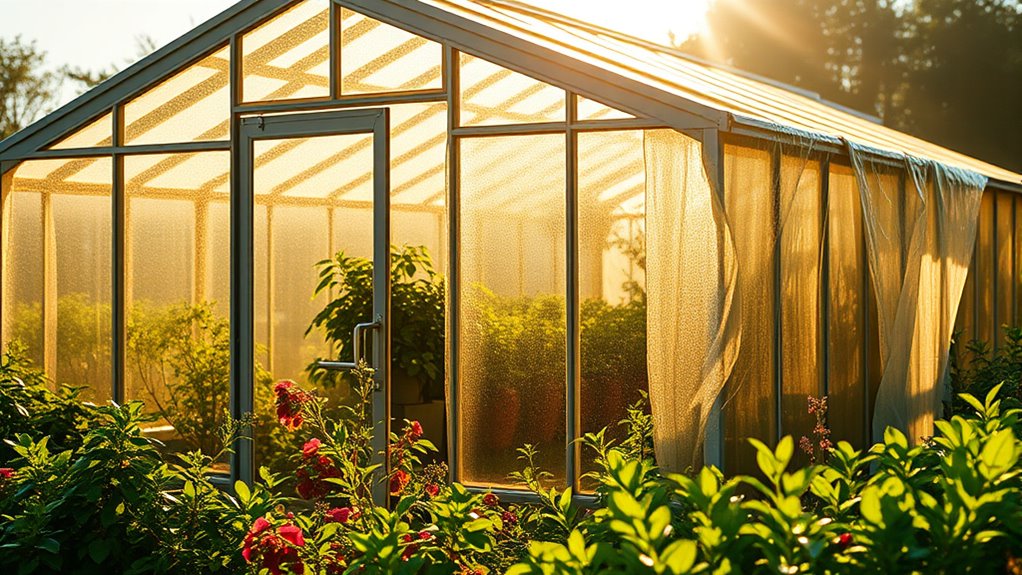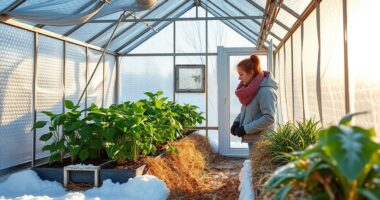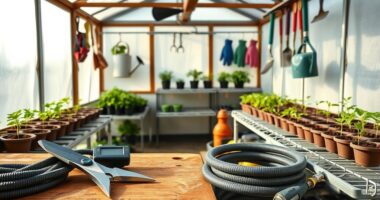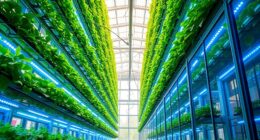When covering your greenhouse, you’ll weigh the pros and cons of glass, polycarbonate, and plastic. Glass offers excellent light transmission and aesthetics, but it can be fragile and costly. Polycarbonate is strong, energy-efficient, and offers great insulation. If you’re on a budget, plastic like polyethylene is affordable but lasts only a few years. Your choice should depend on your budget, climate, and plant needs. You’ll discover more specifics on each option ahead.
Key Takeaways
- Glass offers high light transmission and aesthetic appeal, but is fragile and costly with limited insulation.
- Polycarbonate is shatter-resistant, provides excellent thermal insulation, and lasts 10-15 years, making it a durable choice.
- Polyethylene is the most affordable option but has a short lifespan of 1-4 years, making it less cost-effective long-term.
- SolaWrap combines superior insulation and durability, lasting over a decade, ideal for energy conservation.
- Consider regional climate, light requirements, and budget to choose the best covering material for your greenhouse.
Overview of Greenhouse Covering Materials
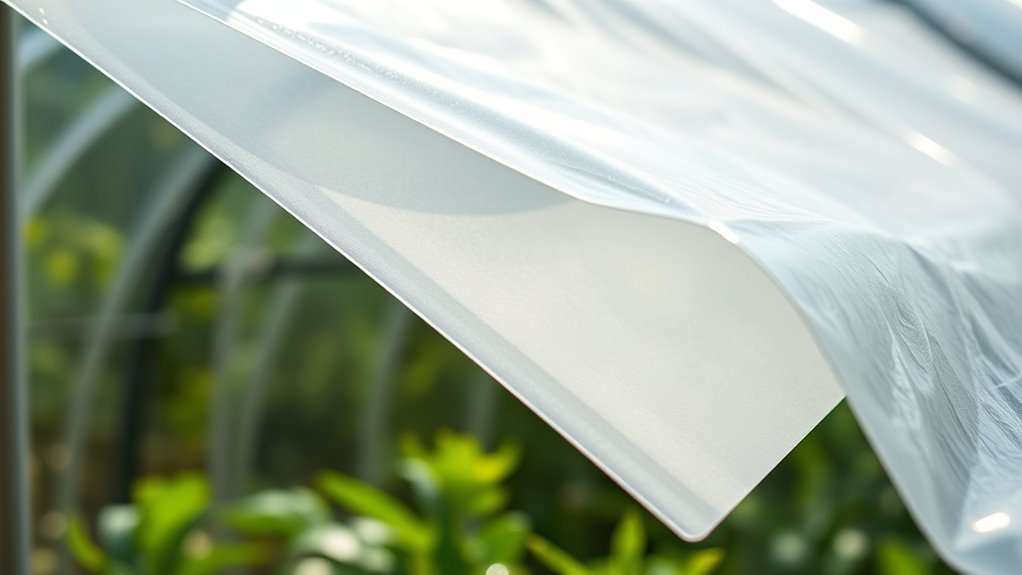
When you’re deciding on greenhouse covering materials, it’s essential to evaluate factors like insulation, durability, and cost.
Polycarbonate is a rigid plastic that offers high thermal efficiency thanks to its multi-wall construction. While it’s pricier than polyethylene, it’s still more affordable than glass and lasts 10-15 years due to its shatter-resistant nature.
On the other hand, polyethylene is the cheapest option but has a short lifespan of 1-4 years, making it susceptible to tearing.
SolaWrap, an advanced bubble film, provides superior insulation and durability, lasting over a decade and offering excellent light diffusion.
Each option has its pros and cons, so consider your specific needs before making a choice.
Advantages and Disadvantages of Glass

Glass greenhouses stand out for their unique advantages and potential drawbacks, making them a popular choice among gardeners. They offer aesthetic appeal and high light transmission, promoting plant growth. Additionally, glass greenhouses can provide optimal growing conditions for a variety of plants when properly maintained. The use of natural materials in construction can further enhance the environmental benefits of a glass greenhouse. Furthermore, energy-efficient models can help reduce heating costs during colder months. However, glass can be fragile and more expensive than alternatives, while also providing limited insulation. Below is a concise comparison of the pros and cons:
| Advantages | Disadvantages | Environmental Considerations |
|---|---|---|
| Aesthetic Appeal | Fragility | Natural Resource |
| High Light Transmission | Higher Costs | Energy Consumption |
| Durability | Limited Insulation | Non-Toxic |
| Easy Replacement | Heavy and Cumbersome | Upcycling Potential |
Consider these factors carefully to decide if a glass greenhouse fits your gardening needs. Additionally, proper routine health checks for plants can help identify issues early, ensuring optimal growth conditions.
Benefits of Polycarbonate Coverings
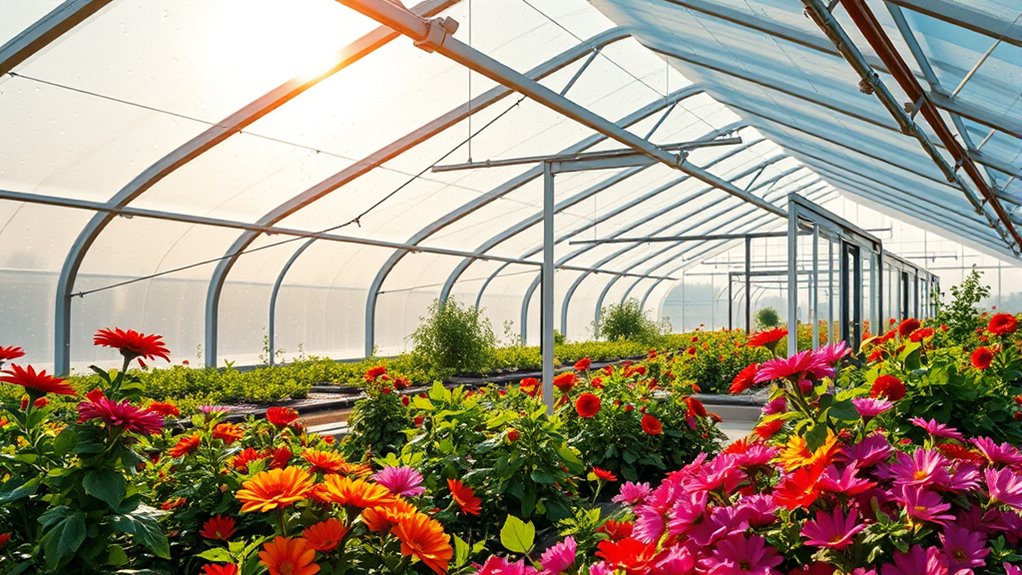
Choosing polycarbonate coverings for your greenhouse can greatly enhance your gardening experience due to their impressive durability and energy efficiency.
These materials are 200 times stronger than glass, making them shatter-resistant and able to withstand harsh weather conditions like hail and snow. With superior thermal insulation, polycarbonate helps maintain a stable inner climate, reducing your heating needs and lowering energy bills.
Additionally, polycarbonate diffuses sunlight evenly, preventing hotspots and promoting balanced plant growth while filtering harmful UV rays. Its flexible design allows for creative shapes, making installation easy.
Exploring Plastic Greenhouse Options

As you explore plastic greenhouse options, you’ll find a variety of materials that cater to different needs and preferences.
Here are three popular choices:
- Polyethylene (PE): Affordable and flexible, PE offers high light transmission but lasts only 2-5 years.
- Polyvinyl Chloride (PVC): Durable and resistant to extreme weather, PVC can last over 10 years, though it raises environmental concerns.
- Polycarbonate: Though not traditional plastic, it’s known for excellent durability and energy efficiency, making it ideal for permanent structures.
Each option has its benefits, from cost-effectiveness to light quality.
Each greenhouse material offers unique advantages, balancing affordability with optimal light conditions for thriving plants.
Understanding these choices will help you select the best material for your greenhouse, ensuring peak plant growth and longevity.
Factors to Consider When Choosing a Covering

When selecting a covering for your greenhouse, it’s essential to take into account several factors that impact plant growth, energy efficiency, and long-term maintenance.
First, consider the light requirements of your crops; for instance, tomatoes thrive on high light intensity, while lettuce prefers less. Choose materials like glass for 90% light transmission or polycarbonate for better light diffusion.
Energy conservation is also key—double poly film offers decent insulation, while triple-pane glass provides even more.
Durability matters too; polycarbonate is shatter-resistant and lightweight, while glass has lower maintenance costs.
Finally, balance your budget with long-term savings, ensuring the covering suits your regional climate and withstands local weather conditions.
Frequently Asked Questions
How Do Temperature Fluctuations Affect Greenhouse Covering Materials?
Temperature fluctuations can greatly impact greenhouse covering materials.
You’ll notice that materials like glass are more prone to breakage in extreme conditions, while polycarbonate offers better durability.
Insulation properties also come into play; polycarbonate retains heat better, reducing heat loss during cold spells.
If you choose plastic, keep in mind it may not handle these fluctuations as effectively.
Ultimately, understanding these effects helps you maintain a stable environment for your plants.
Can I Mix Different Covering Materials in One Greenhouse?
Yes, you can mix different covering materials in one greenhouse, but it comes with challenges.
You’ll need to guarantee structural integrity and proper insulation, as varying materials can affect heat retention and light diffusion.
Mixing allows for customization based on plant needs, but be cautious about maintenance and durability.
Consider the aesthetics and functionality of each material to create an effective and visually appealing greenhouse environment.
What Is the Lifespan of Each Greenhouse Covering Material?
The lifespan of greenhouse covering materials varies greatly.
Glass typically lasts 20 to 30 years with proper care, while polycarbonate can range from 5 to 15 years, extending up to 20 with high-quality options.
Plastic covers are the shortest-lived, usually lasting 1 to 4 years.
Factors like weather conditions, material quality, and maintenance play essential roles in determining how long each type will effectively protect your plants.
Regular maintenance is key for longevity.
How Do I Properly Maintain Each Type of Greenhouse Covering?
Maintaining your greenhouse covering is as essential as keeping a garden of gold!
For glass, clean regularly and inspect for cracks.
With polycarbonate, use mild detergent and check for scratches.
For plastic, choose high-quality sheeting and clean it at least once a year.
Always guarantee proper ventilation and watch for pests.
Regular inspections and prompt repairs will keep your greenhouse thriving, so don’t let any damage go unnoticed!
Are There Any Eco-Friendly Options for Greenhouse Coverings?
Yes, there are several eco-friendly options for greenhouse coverings that you can consider.
Recycled polycarbonate panels and fiberglass offer durability while reducing waste. Biodegradable plastic panels break down naturally, helping the environment.
Tempered glass is fully recyclable and provides excellent light transmission.
These materials not only contribute to sustainable practices but also enhance energy efficiency, ensuring your greenhouse maintains ideal conditions for your plants while being kind to the planet.
Conclusion
In choosing the right greenhouse covering, you’re not just picking a material; you’re setting the stage for your plants’ success. Whether you lean towards glass, polycarbonate, or plastic, each option offers unique benefits and drawbacks. Just like a gardener nurtures their plants, consider your specific needs and local climate to guarantee your greenhouse thrives. Ultimately, the right choice can make your gardening dreams bloom into a vibrant reality. So, choose wisely and watch your garden flourish!
